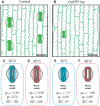Impact of Stomatal Density and Morphology on Water-Use Efficiency in a Changing World
- PMID: 30894867
- PMCID: PMC6414756
- DOI: 10.3389/fpls.2019.00225
Impact of Stomatal Density and Morphology on Water-Use Efficiency in a Changing World
Abstract
Global warming and associated precipitation changes will negatively impact on many agricultural ecosystems. Major food production areas are expected to experience reduced water availability and increased frequency of drought over the coming decades. In affected areas, this is expected to reduce the production of important food crops including wheat, rice, and maize. The development of crop varieties able to sustain or improve yields with less water input is, therefore, a priority for crop research. Almost all water used for plant growth is lost to the atmosphere by transpiration through stomatal pores on the leaf epidermis. By altering stomatal pore apertures, plants are able to optimize their CO2 uptake for photosynthesis while minimizing water loss. Over longer periods, stomatal development may also be adjusted, with stomatal size and density being adapted to suit the prevailing conditions. Several approaches to improve drought tolerance and water-use efficiency through the modification of stomatal traits have been tested in the model plant Arabidopsis thaliana. However, there is surprisingly little known about the stomata of crop species. Here, we review the current understanding of how stomatal number and morphology are involved in regulating water-use efficiency. Moreover, we discuss the potential and limitations of manipulating stomatal development to increase drought tolerance and to reduce water loss in crops as the climate changes.
Keywords: crops; drought response; stomatal conductance; stomatal density and size; water-use efficiency.
Figures


References
-
- Bacon M. (2004). Water use efficiency in plant biology. Oxford, UK: Blackwell.
-
- Bakker J. C. (1991). Effects of humidity on stomatal density and its relation to leaf conductance. Sci. Hortic. 48, 205–212. 10.1016/0304-4238(91)90128-L - DOI
Publication types
LinkOut - more resources
Full Text Sources
Other Literature Sources

